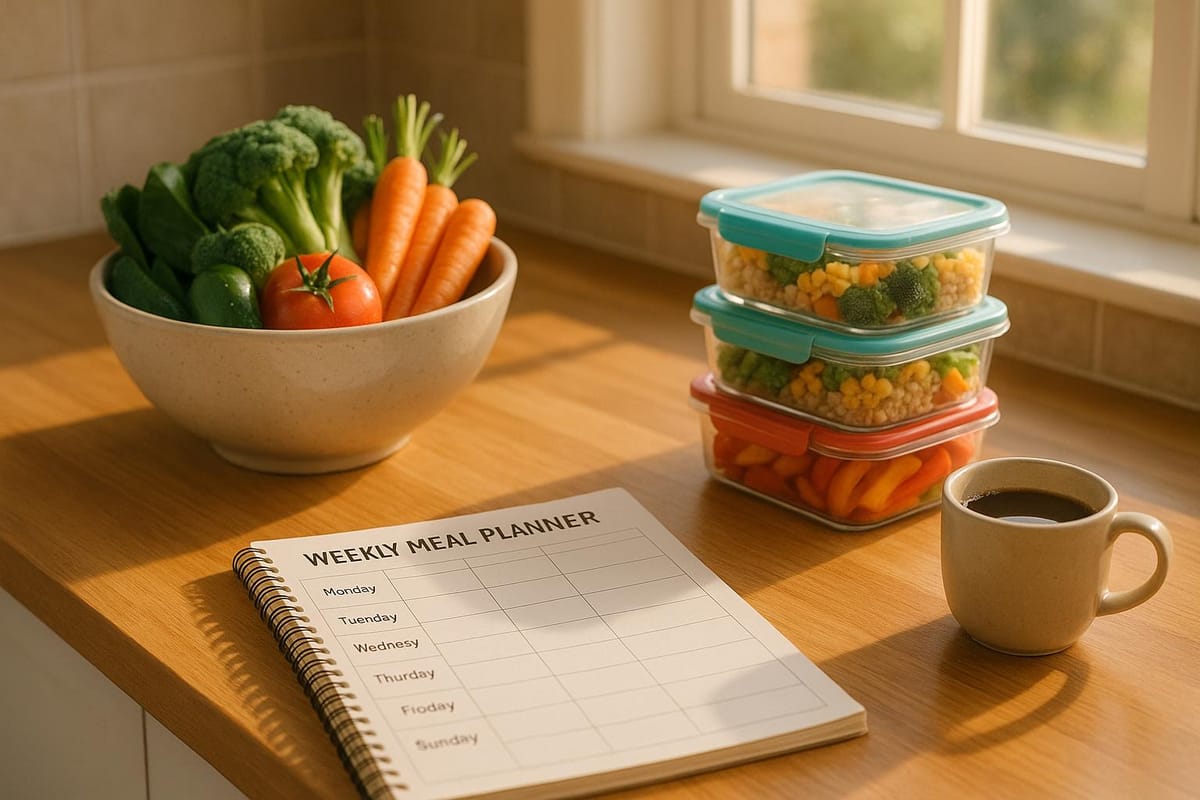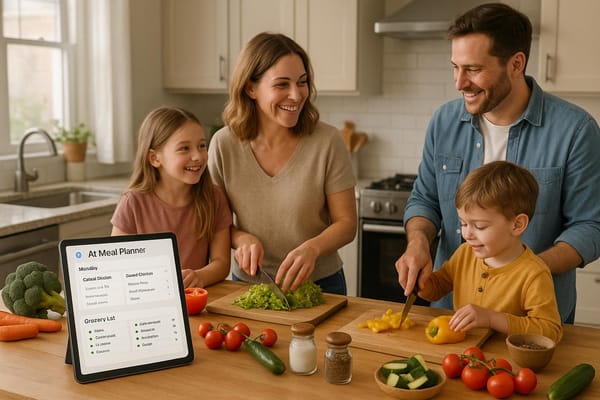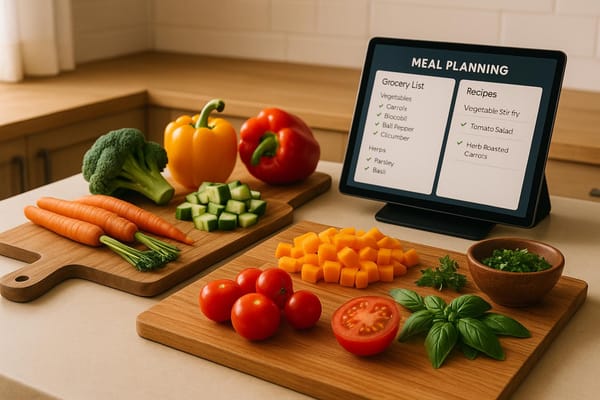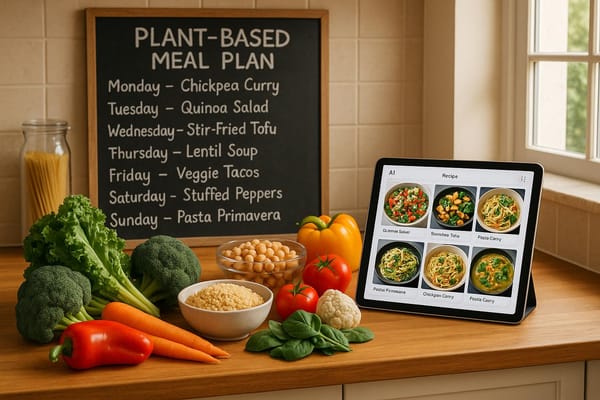Weekly Meal Planning: 5 Steps to Get Started
Simplify your cooking routine and reduce stress with effective weekly meal planning strategies that save time and money.

Tired of last-minute meal decisions and wasted groceries? Weekly meal planning can simplify your life, save money, and reduce stress. Here's how to get started:
- Check Your Schedule: Plan meals based on your week's activities. Use busy days for leftovers or quick options and free days for batch cooking.
- Choose Recipes: Mix familiar dishes with new ones. Focus on seasonal ingredients and sales for variety and savings.
- Make a Grocery List: Organize by store sections to save time and stick to your budget.
- Prep and Cook: Dedicate a day to prepare proteins, grains, and veggies in bulk. Store meals properly for freshness.
- Stay Flexible: Adjust your plan as needed and involve your family for smoother planning.
Bonus Tip: Tools like Honeydew Recipe Manager can streamline planning with features like AI-generated grocery lists and shared calendars. Start small, build the habit, and enjoy stress-free meals!
How to Create (and Stick To!) a Weekly Meal Plan | 5 EASY STEPS!
Step 1: Check Your Schedule and Food Needs
Start by taking a close look at your week to figure out how many meals you'll need and what kind of prep they require. Some days might call for full-on cooking, while others might be perfect for leftovers or quick-fix options. Your calendar is your best tool for planning this out.
Review Your Weekly Schedule
Go day by day and match your meal prep to your schedule. Got a packed weekday? Stick to meals that are quick to prepare or plan to use leftovers. If you’ve got evening plans or family activities, it’s smart to go with something that takes minimal effort.
On days when you have more time, consider batch cooking. It’s a great way to prepare meals in advance and save yourself some hassle later in the week. And for those low-energy days? Simple, reheatable meals are your best friends.
Step 2: Pick Recipes and Plan Your Meals
With your schedule in place, it’s time to choose meals that strike a balance between variety, nutrition, and practicality. By building on your planned routine, these tips can help you refine your recipe selection and make meal planning more efficient.
Choose a Mix of Familiar and New Recipes
Blend your trusted favorites with a few new dishes to keep things interesting without overwhelming yourself. Start with recipes you know well - those dependable meals that make hectic days easier. Then, sprinkle in one or two new options each week to expand your repertoire and keep things fresh.
When picking recipes, aim for variety in your protein sources throughout the week. For example, you could plan for chicken one day, fish another, and a plant-based option midweek. Switching up cooking techniques - like using a slow cooker for convenience or stir-frying for quick meals - adds even more variety to your menu.
Plan Around Seasonal and Discounted Ingredients
Using seasonal produce not only enhances flavor but can also be a budget-friendly choice. Think of squash in the fall or tomatoes in the summer as the foundation for your meals. Seasonal ingredients often taste better and cost less, making them a win-win.
Before finalizing your meal plan, check your grocery store’s weekly ads. If you spot sales on items like chicken thighs, consider planning several meals around them. Cooking extra portions and freezing them for later can also stretch your budget further.
Don’t forget pantry staples when they’re on sale. Stock up on essentials like canned tomatoes, pasta, rice, and frozen vegetables - these items can form the base of countless meals. Planning around these staples can save you money and reduce last-minute trips to the store.
Simplify Planning with Honeydew Recipe Manager

Honeydew Recipe Manager can take the stress out of meal planning. This app offers handy features like smart AI import, a drag-and-drop calendar, and AI-generated menus tailored to your dietary goals. It even allows family members to contribute, making it easier to adjust plans when schedules shift.
The smart AI import feature lets you save recipes directly from social media, cooking websites, or even photos of handwritten family recipes. Instead of juggling bookmarks or screenshots, everything stays neatly organized in one place. And with the drag-and-drop calendar, you can easily map out your week and rearrange meals as needed.
Step 3: Make a Grocery List
Once your meals are planned, creating a grocery list tailored to those recipes is the next step. A well-thought-out list not only saves time at the store but also ensures you grab everything you need without overspending. For even more efficiency, organize your list to match the layout of your favorite grocery store.
Group Items by Store Sections
To make shopping easier, group your items based on store sections like produce, dairy, meat and seafood, pantry staples, frozen foods, and household items. Be specific with quantities - for example, write "2 lbs. boneless chicken thighs" instead of just "chicken." This helps you stick to your budget and ensures you buy the right amounts for your recipes.
Use AI-Generated Grocery Lists
For a more streamlined experience, consider using tools like the Honeydew Recipe Manager. This app simplifies the process by automatically generating a shopping list based on your meal plan, calculating exact ingredient amounts, and even offering smart substitutions if something is unavailable. It organizes everything by store sections, so you can shop more efficiently.
Honeydew also integrates with Instacart for one-click ordering, bringing groceries straight to your door. Plus, family members can add items to a shared list throughout the week, cutting down on forgotten items and those last-minute trips to the store.
Users have reported saving both time and money with this tool while reducing food waste. The Free Plan includes basic grocery list generation, making it accessible for beginners. For more advanced features like smart substitutions, you can upgrade to Honeydew Plus for $4.17 per month when billed annually (about $1.00 per week). With a 4.8-star rating from over 5,200 reviews on Google Play, users consistently highlight how much easier meal planning and shopping become with this app.
Step 4: Prep and Cook Your Meals
Now that your groceries are ready, it’s time to turn them into meals for the week. Meal prep is where you set yourself up for success, saving time and stress during busy weekdays. By dedicating a few hours to prepping and cooking, you can create versatile components that work across multiple meals. The trick? Work smarter, not harder.
Set Aside a Meal Prep Day
Pick one day each week to focus solely on meal prep. For many, Sunday afternoons are ideal, giving you fresh meals to kick off the week. Plan for 2–3 hours of dedicated prep time.
Start by batch cooking your proteins. Prepare 2–3 pounds of your choice - chicken, turkey, or even plant-based options like tofu. Add variety by seasoning portions differently: think Italian herbs for one batch, taco seasoning for another, and just salt and pepper for a neutral option. While your proteins cook, make a large batch of grains or starches, like brown rice, quinoa, or roasted sweet potatoes, which can serve as meal bases.
Vegetables are next. Wash, chop, and roast them in bulk. For example, slice bell peppers, onions, and zucchini for stir-fries, and roast broccoli, carrots, or Brussels sprouts with olive oil and seasonings. Prepping vegetables ahead of time means you can quickly assemble a healthy meal without extra hassle.
Don’t forget breakfast! Preparing grab-and-go options can make mornings much smoother. Try overnight oats, egg muffins baked in a muffin tin, or pre-packaged smoothie ingredients stored in freezer bags. These options reduce decision-making when you’re short on time.
Store Meals to Keep Them Fresh
Once everything is cooked, proper storage will keep your meals fresh and ready to go. Use microwave-safe glass containers with tight lids for easy reheating and organization.
Portion your meals immediately. Divide proteins, grains, and vegetables into single-serving containers so you only heat what you need. Label each container with the contents and date to avoid confusion later. Most meals will stay fresh in the fridge for 3–4 days. If you’re prepping for a longer stretch, freeze half of your portions. Soups, stews, and casseroles are great for freezing - store them in single-serving sizes so you can thaw only what you need.
For raw meats, store them on the bottom shelf of your fridge to avoid contamination, and always use separate cutting boards for raw meat and vegetables during prep.
Some dishes, like salads, don’t reheat well. For these, prep the components separately. Wash and chop lettuce, store dressings in small containers, and cook proteins ahead of time. This way, you can quickly assemble fresh salads each day.
Lastly, let your food cool completely before storing it in the fridge. Putting hot food directly into the refrigerator can raise its internal temperature, potentially affecting other items stored inside.
Step 5: Follow and Adjust Your Meal Plan
Think of your meal plan as a guide, not a rigid rulebook. Even with the best intentions, life has a way of throwing curveballs - unexpected dinner invitations, last-minute schedule changes, or simply a craving for something different. And that’s okay! Flexibility is key to keeping your meal planning practical and enjoyable.
With Honeydew’s drag-and-drop calendar, adjusting your plan is a breeze. Say you’ve got grilled chicken lined up for Tuesday, but a dinner out pops up instead - just move it to Wednesday. If bigger changes are needed, like missing ingredients or a completely rearranged schedule, Honeydew’s AI meal planner can save the day. It quickly recalculates and updates your weekly menu in seconds, giving you a fresh plan tailored to your new situation.
When ingredients aren’t available, the app also suggests smart substitutions to keep you on track without the stress of a grocery store run.
Learn from your experience. Pay attention to what works and what doesn’t. Maybe your family loves taco night but isn’t a fan of that quinoa salad. Or perhaps Friday nights are consistently tricky because everyone’s drained from the week. These observations can help you fine-tune your future plans, making them even more effective.
Work with Family Members
Meal planning becomes much easier - and more enjoyable - when everyone in the household is involved. Getting your family on board early can prevent complaints and ensure meals that everyone is happy to eat.
Honeydew Recipe Manager makes this collaboration simple with its household sharing feature. Up to six family members can access the shared meal plan, suggest recipes, and see what’s coming up for the week. This way, you avoid those groan-inducing surprise dinners, and everyone feels included in the process.
Consider setting aside a few minutes each week - maybe after Sunday dinner - to review the upcoming meal plan as a family. Talk about cravings, note any schedule conflicts, and brainstorm new recipes to try. Including children in the planning process can even make them more willing to eat what’s served without fuss.
For busy families where cooking duties are shared, this collaborative approach is especially helpful. For instance, your spouse can check the app to see they’re in charge of Wednesday’s dinner and access the recipe instantly. Meanwhile, teenagers can look up after-school snack options and even suggest swaps if they’re not feeling what’s planned.
Share responsibilities based on age. Younger kids can help with tasks like washing veggies or setting the table, while older ones might take on cooking a dish or two. Giving everyone a role not only lightens your load but also makes meal prep a family effort.
And don’t forget to stay flexible with preferences. If your teenager suddenly decides they’re over that pasta dish they used to love, don’t force it. Use the app’s quick replanning feature to find an alternative, or let them whip up something else while the rest of the family sticks to the plan. Flexibility isn’t just about schedules - it’s about keeping everyone happy and engaged.
Start Your Meal Planning Today
Take control of your week with just a few straightforward steps. Simplify your grocery trips, cut down on waste, and save yourself hours of stress. Ready to dive in? Let’s get started.
Start small - choose three or four easy recipes to kick things off. Stick to meals you’re already comfortable making, and as you get into the rhythm of planning, you can gradually add new dishes to your rotation. Meal planning gets easier with practice, so give yourself time to build the habit.
If you’re looking for a tool to make the process even smoother, Honeydew Recipe Manager might be just what you need. This app offers AI-powered menu suggestions, a drag-and-drop calendar, automatic grocery lists, and even household sharing. The best part? You can start for free! The free version includes smart recipe imports for up to 10 recipes and basic planning features. For those who want more, advanced tools are available for just $4.17/month.
Here’s the key to meal planning: it’s not about being perfect - it’s about making life easier. Some weeks will go exactly as planned, while others might require a bit of last-minute flexibility. And that’s okay! The goal is to spend less time stressing over “what’s for dinner?” and more time savoring meals you’ve thoughtfully prepared.
Ready to make dinnertime stress a thing of the past? Download Honeydew Recipe Manager today and start simplifying your evenings. Meal planning doesn’t just save time - it lets you enjoy the moments that matter most.
FAQs
How can I get my family involved in meal planning so everyone enjoys the meals?
Getting your family involved in meal planning can make dinnertime more enjoyable for everyone. Start by gathering input from each family member - ask them to share their favorite meals or recipe ideas. Jot these down somewhere handy, like a whiteboard, notebook, or even a digital planner. This way, everyone feels their preferences are valued and included.
Turn meal planning into a fun family tradition. You could brainstorm new recipes together, let the kids choose a theme for the week (like "Taco Tuesday" or "Pasta Night"), or have them pitch in with simple tasks like writing out the grocery list. Cooking as a family doesn't just teach useful kitchen skills - it’s also a great way to strengthen your bond. Keep the menu straightforward and flexible to accommodate everyone's busy lives, while still making sure the meals are something everyone will look forward to.
How can I stay flexible with my meal plan when unexpected events come up?
Staying flexible with your meal plan comes down to being prepared and open to change. Stock up on a few quick, no-fuss options like frozen meals or pantry staples. These can be lifesavers when your day takes an unexpected turn. Instead of sticking to a rigid schedule, consider following a loose meal framework that lets you adapt based on your daily needs.
Another helpful strategy is batch cooking or prepping ingredients ahead of time. This not only saves you time but also makes it easier to tweak your meals on the fly. By choosing recipes that allow for ingredient swaps and versatility, you can keep up with healthy eating - even when life throws you a curveball.
How can using seasonal and on-sale ingredients save money and add variety to my meal plan?
Using seasonal ingredients is a smart way to save money, as they tend to be more abundant and less expensive during their peak harvest times. Stocking up on sale items - especially when buying in bulk - can also help stretch your grocery dollars further, making it easier to manage your food budget.
Adding seasonal produce to your meals keeps things interesting by bringing a rotating variety of fresh ingredients to your table. Not only does this make your meals more enjoyable, but it also ensures you're getting a diverse mix of nutrients throughout the year. It's an easy and effective approach to keep your meals affordable, healthy, and full of flavor!




